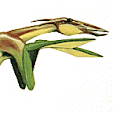It has been a while since I last posted something here. There were multiple reasons for that: the realisation that there are more than enough paintings for The Book lessened my enthusiasm to start new Furaha paintings. An interesting side effect of that is that I started painting a series of paintings completely unrelated to speculative biology, which was refreshing. So much so, in fact, that having finished three such paintings I became eager to do some more Furahan creatures.
Another factor is that the number of views and replies has been fairly low lately. Is a blog like this one too old-fashioned, or perhaps too complex? No longer interesting? Or is it too difficult to leave a reply? I thought so when I wanted to write something on someone else's blog. Ideas and thoughts are welcome.
 |
| Click to enlarge; copyright Gert van Dijk |
Anyway, here is a detail of a work in progress showing a 'pied stickler' (Perfixor artifex). The name means 'cunning impaler'. A part of the accompanying text follows.
Katarzyna Altanero, who devoted her life to the study of hexapod carnivores, described sticklers as ‘prototypical gregarious piluferentic centauraptors’. This statement shows that doctissimus Altanero was one of those people who, once they have learned something, think that people are born with that knowledge already in place. But the cumbersome jargon is correct.
'Centauraptors’
These animals are obviously hexapods, but they have freed their front legs from all locomotion duties, a principle known on Furaha as ‘centaurism’. Here, the limbs have become weapons.
Centaurism probably involves very quick evolution. The front limbs, liberated from walking, were free to quickly evolve suitable shapes for their new roles. At the same time the balance and locomotion of the animal changed drastically. The front part of the trunk became shorter and was tilted upwards, while the former middle legs increased in size and moved forwards.
These changes must have evolved hand in hand with specialisation to a specific way of catching prey. For instance, predators relying on speed should not carry massive heavy clubs, and those aiming to bring down armoured prey must have adequate weaponry and need only be faster than their prey. Scavenging centauraptors can be slow , allowing some of the heaviest weaponry of all.
‘Piluferentic’
Centauraptor weapons betray an interesting array of forms. Some are pure clubs, others function only as ‘pointy end’ weapons, and in yet others the limb has more than one purpose. The limb type known as ‘axes’ have a sharp edge on the underside, useful to hack open a carcass, but the same weapon usually has a heavy bulge too, allowing it to double as a club to knock prey off their feet or to bludgeon the prey's head, blinding it.
The stickler’s weapons are no exception to this ‘Swiss army knife’ approach. While its weapon is primarily shaped like a club, the former foot has become a sharp protrusion that can be swung into action. This sting explains the word ‘piluferens’, meaning 'lance carrying’.
‘Gregarious’
As the word suggests, sticklers live in groups. In this species’ case, tasks differ between group members, allowing a fairly complex society that must run on advanced cognitive capacity. Do not underestimate sticklers; one may appear to study you with open curiosity, but its pack members may well be behind you, on their way to encircle you. They cannot digest humans but that makes little difference to the human involved.
